Accounting Theory Assignment 1: Corporate Governance in Australia
VerifiedAdded on 2023/04/03
|10
|2498
|306
Report
AI Summary
This accounting assignment analyzes corporate governance through a case study of Woolworths Group and Wesfarmers, examining their annual reports, corporate governance indicators (board composition, director independence, and shareholdings), and disclosure approaches. The assignment then delves into an essay on corporate governance, defining the term, outlining its characteristics (transparency, accountability, etc.), and emphasizing its importance in corporate success. The essay explores the interconnectedness of corporate governance and accounting, highlighting how good governance supports strong accounting systems, enhances financial reporting quality, and attracts investor funds. It uses examples like Enron, WorldCom, Lehman Brothers, and Satyam to illustrate the consequences of poor governance. The role of the board of directors is discussed, emphasizing the importance of independent directors. Finally, it outlines different approaches to corporate governance (rule-based, principles-based, agency theory, stakeholder approach), and mentions the role of regulatory bodies like ASIC in Australia. The assignment highlights the significance of corporate governance in maintaining the integrity of financial systems and investor confidence.
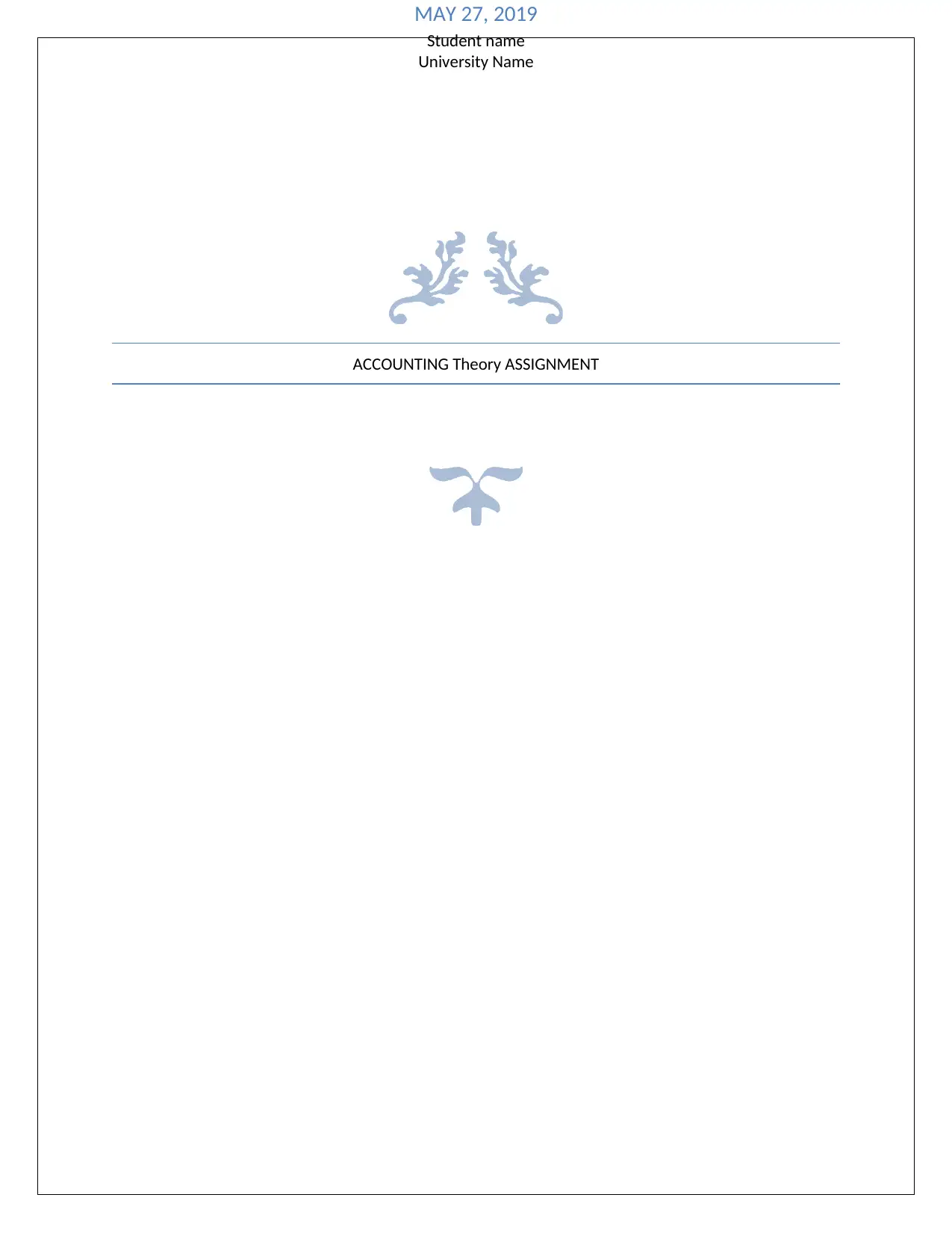
ACCOUNTING Theory ASSIGNMENT
MAY 27, 2019
Student name
University Name
MAY 27, 2019
Student name
University Name
Paraphrase This Document
Need a fresh take? Get an instant paraphrase of this document with our AI Paraphraser

1
By student name
Professor
University
Date: 16 May 2019.
1 | P a g e
By student name
Professor
University
Date: 16 May 2019.
1 | P a g e
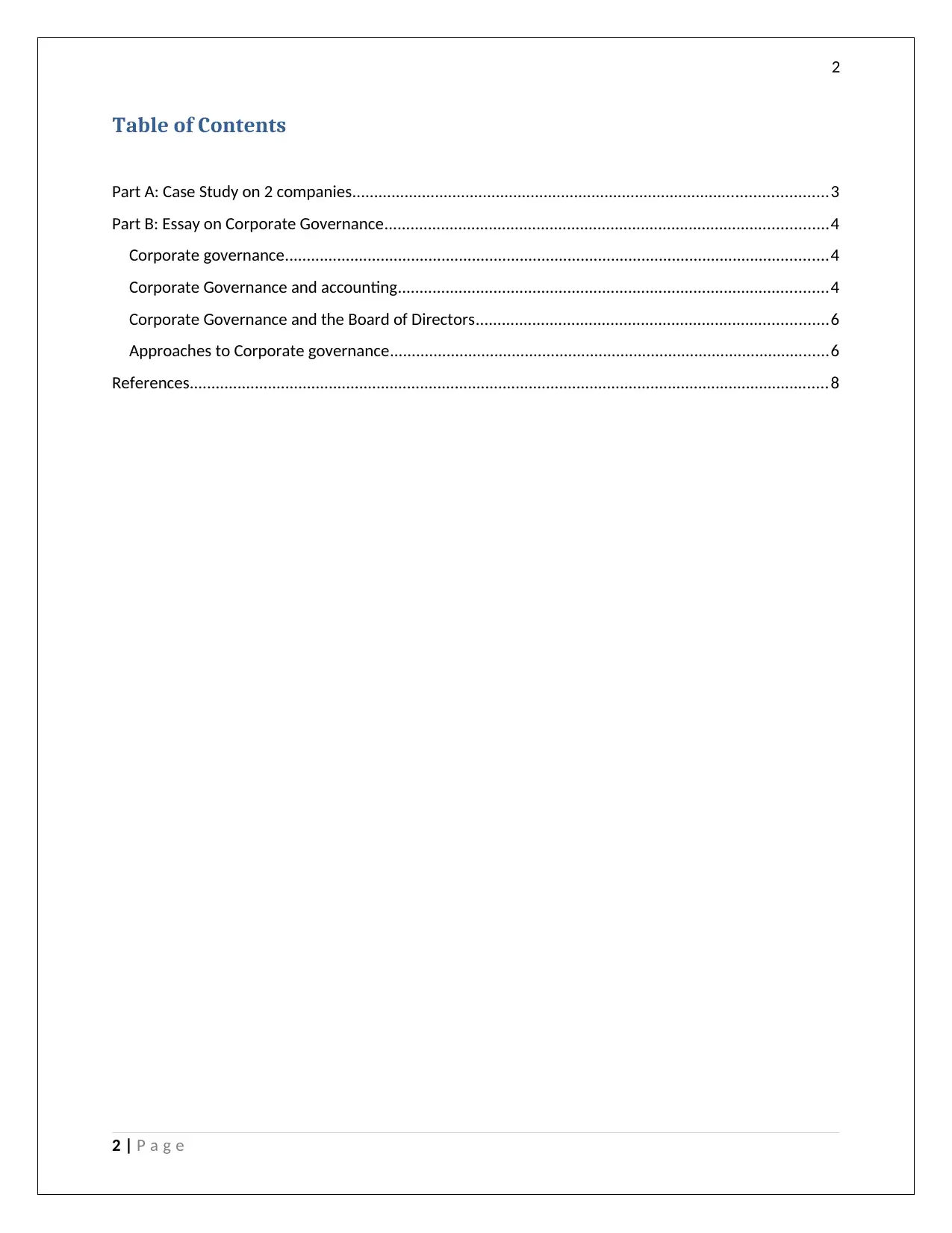
2
Table of Contents
Part A: Case Study on 2 companies.............................................................................................................3
Part B: Essay on Corporate Governance......................................................................................................4
Corporate governance.............................................................................................................................4
Corporate Governance and accounting...................................................................................................4
Corporate Governance and the Board of Directors.................................................................................6
Approaches to Corporate governance.....................................................................................................6
References...................................................................................................................................................8
2 | P a g e
Table of Contents
Part A: Case Study on 2 companies.............................................................................................................3
Part B: Essay on Corporate Governance......................................................................................................4
Corporate governance.............................................................................................................................4
Corporate Governance and accounting...................................................................................................4
Corporate Governance and the Board of Directors.................................................................................6
Approaches to Corporate governance.....................................................................................................6
References...................................................................................................................................................8
2 | P a g e
⊘ This is a preview!⊘
Do you want full access?
Subscribe today to unlock all pages.

Trusted by 1+ million students worldwide
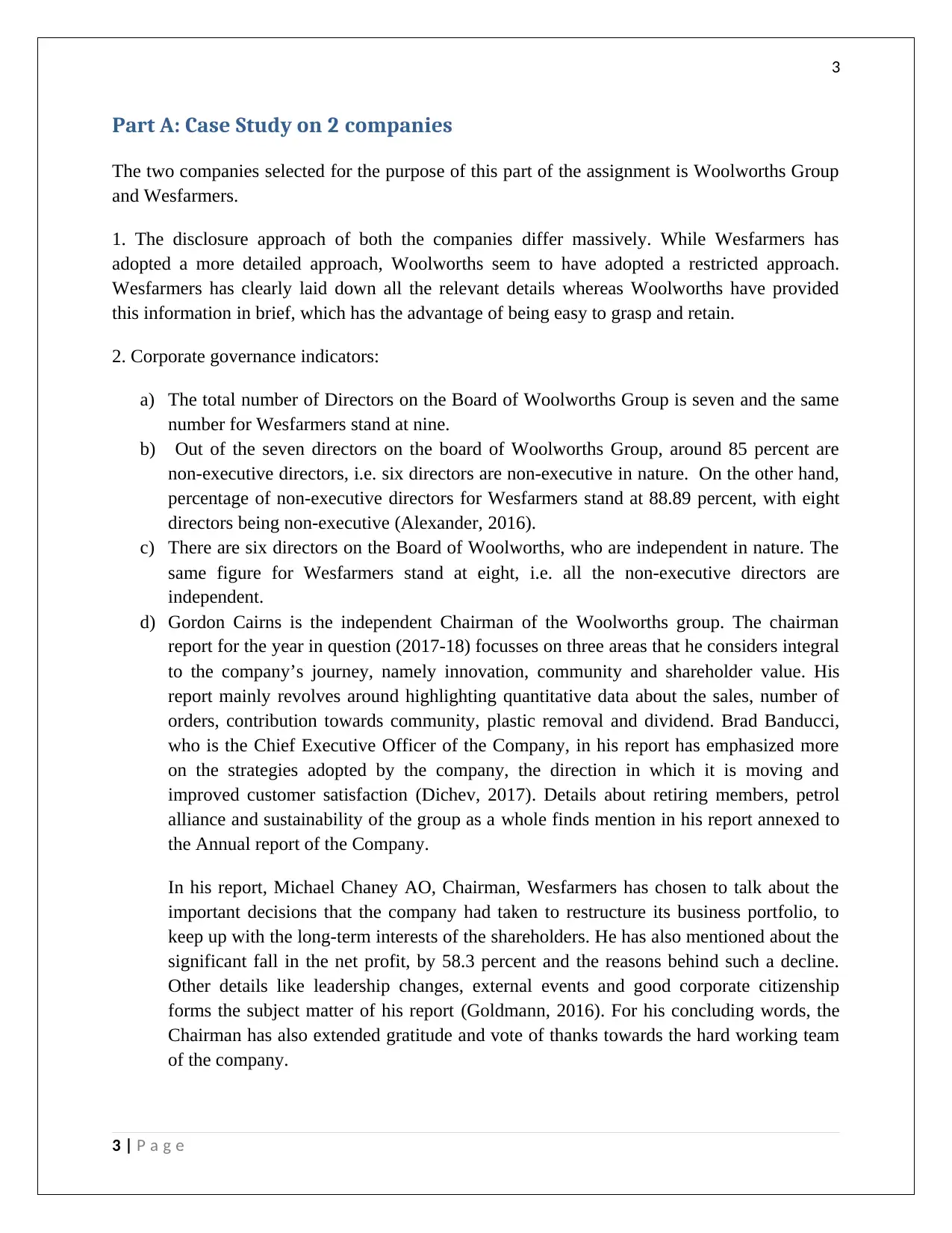
3
Part A: Case Study on 2 companies
The two companies selected for the purpose of this part of the assignment is Woolworths Group
and Wesfarmers.
1. The disclosure approach of both the companies differ massively. While Wesfarmers has
adopted a more detailed approach, Woolworths seem to have adopted a restricted approach.
Wesfarmers has clearly laid down all the relevant details whereas Woolworths have provided
this information in brief, which has the advantage of being easy to grasp and retain.
2. Corporate governance indicators:
a) The total number of Directors on the Board of Woolworths Group is seven and the same
number for Wesfarmers stand at nine.
b) Out of the seven directors on the board of Woolworths Group, around 85 percent are
non-executive directors, i.e. six directors are non-executive in nature. On the other hand,
percentage of non-executive directors for Wesfarmers stand at 88.89 percent, with eight
directors being non-executive (Alexander, 2016).
c) There are six directors on the Board of Woolworths, who are independent in nature. The
same figure for Wesfarmers stand at eight, i.e. all the non-executive directors are
independent.
d) Gordon Cairns is the independent Chairman of the Woolworths group. The chairman
report for the year in question (2017-18) focusses on three areas that he considers integral
to the company’s journey, namely innovation, community and shareholder value. His
report mainly revolves around highlighting quantitative data about the sales, number of
orders, contribution towards community, plastic removal and dividend. Brad Banducci,
who is the Chief Executive Officer of the Company, in his report has emphasized more
on the strategies adopted by the company, the direction in which it is moving and
improved customer satisfaction (Dichev, 2017). Details about retiring members, petrol
alliance and sustainability of the group as a whole finds mention in his report annexed to
the Annual report of the Company.
In his report, Michael Chaney AO, Chairman, Wesfarmers has chosen to talk about the
important decisions that the company had taken to restructure its business portfolio, to
keep up with the long-term interests of the shareholders. He has also mentioned about the
significant fall in the net profit, by 58.3 percent and the reasons behind such a decline.
Other details like leadership changes, external events and good corporate citizenship
forms the subject matter of his report (Goldmann, 2016). For his concluding words, the
Chairman has also extended gratitude and vote of thanks towards the hard working team
of the company.
3 | P a g e
Part A: Case Study on 2 companies
The two companies selected for the purpose of this part of the assignment is Woolworths Group
and Wesfarmers.
1. The disclosure approach of both the companies differ massively. While Wesfarmers has
adopted a more detailed approach, Woolworths seem to have adopted a restricted approach.
Wesfarmers has clearly laid down all the relevant details whereas Woolworths have provided
this information in brief, which has the advantage of being easy to grasp and retain.
2. Corporate governance indicators:
a) The total number of Directors on the Board of Woolworths Group is seven and the same
number for Wesfarmers stand at nine.
b) Out of the seven directors on the board of Woolworths Group, around 85 percent are
non-executive directors, i.e. six directors are non-executive in nature. On the other hand,
percentage of non-executive directors for Wesfarmers stand at 88.89 percent, with eight
directors being non-executive (Alexander, 2016).
c) There are six directors on the Board of Woolworths, who are independent in nature. The
same figure for Wesfarmers stand at eight, i.e. all the non-executive directors are
independent.
d) Gordon Cairns is the independent Chairman of the Woolworths group. The chairman
report for the year in question (2017-18) focusses on three areas that he considers integral
to the company’s journey, namely innovation, community and shareholder value. His
report mainly revolves around highlighting quantitative data about the sales, number of
orders, contribution towards community, plastic removal and dividend. Brad Banducci,
who is the Chief Executive Officer of the Company, in his report has emphasized more
on the strategies adopted by the company, the direction in which it is moving and
improved customer satisfaction (Dichev, 2017). Details about retiring members, petrol
alliance and sustainability of the group as a whole finds mention in his report annexed to
the Annual report of the Company.
In his report, Michael Chaney AO, Chairman, Wesfarmers has chosen to talk about the
important decisions that the company had taken to restructure its business portfolio, to
keep up with the long-term interests of the shareholders. He has also mentioned about the
significant fall in the net profit, by 58.3 percent and the reasons behind such a decline.
Other details like leadership changes, external events and good corporate citizenship
forms the subject matter of his report (Goldmann, 2016). For his concluding words, the
Chairman has also extended gratitude and vote of thanks towards the hard working team
of the company.
3 | P a g e
Paraphrase This Document
Need a fresh take? Get an instant paraphrase of this document with our AI Paraphraser
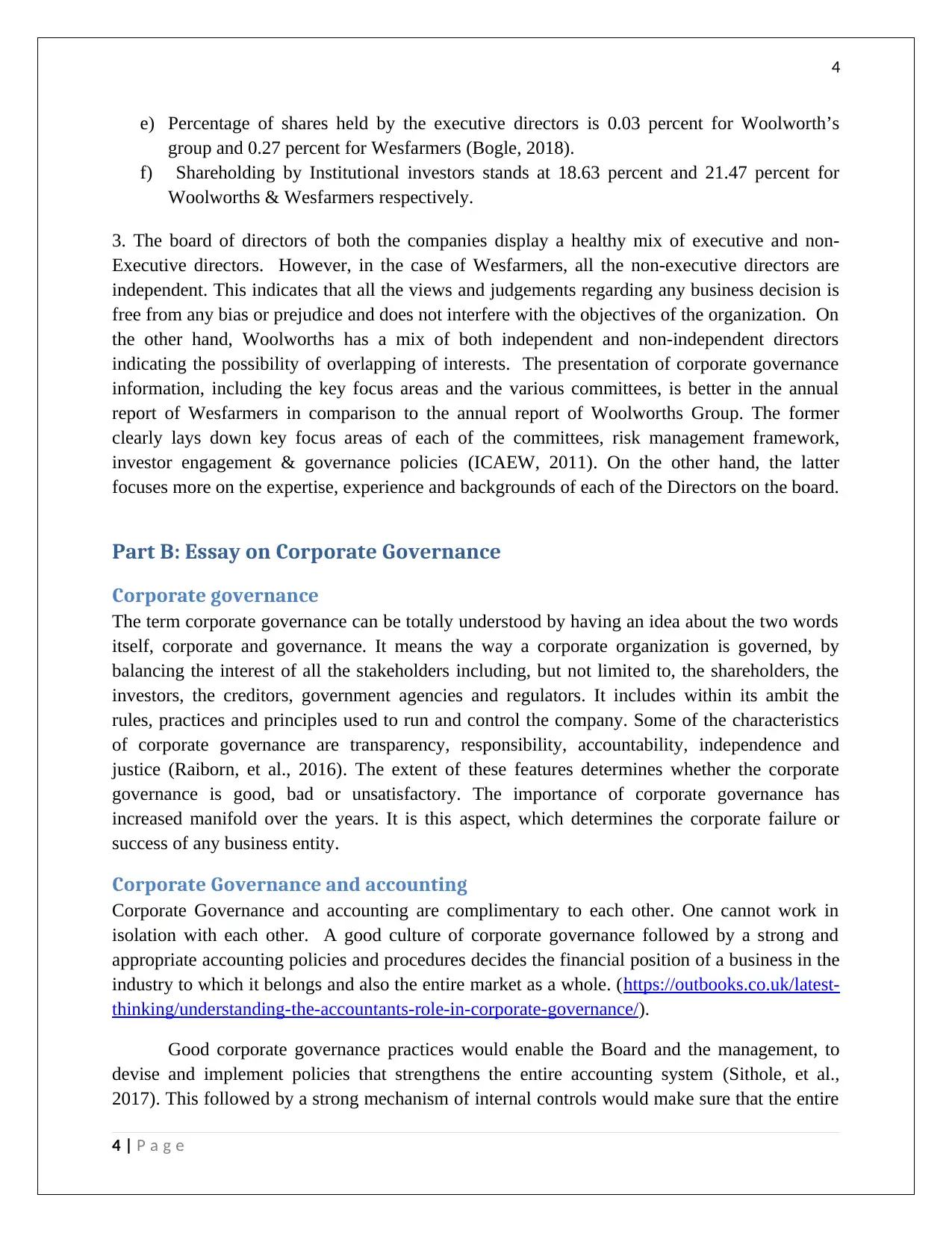
4
e) Percentage of shares held by the executive directors is 0.03 percent for Woolworth’s
group and 0.27 percent for Wesfarmers (Bogle, 2018).
f) Shareholding by Institutional investors stands at 18.63 percent and 21.47 percent for
Woolworths & Wesfarmers respectively.
3. The board of directors of both the companies display a healthy mix of executive and non-
Executive directors. However, in the case of Wesfarmers, all the non-executive directors are
independent. This indicates that all the views and judgements regarding any business decision is
free from any bias or prejudice and does not interfere with the objectives of the organization. On
the other hand, Woolworths has a mix of both independent and non-independent directors
indicating the possibility of overlapping of interests. The presentation of corporate governance
information, including the key focus areas and the various committees, is better in the annual
report of Wesfarmers in comparison to the annual report of Woolworths Group. The former
clearly lays down key focus areas of each of the committees, risk management framework,
investor engagement & governance policies (ICAEW, 2011). On the other hand, the latter
focuses more on the expertise, experience and backgrounds of each of the Directors on the board.
Part B: Essay on Corporate Governance
Corporate governance
The term corporate governance can be totally understood by having an idea about the two words
itself, corporate and governance. It means the way a corporate organization is governed, by
balancing the interest of all the stakeholders including, but not limited to, the shareholders, the
investors, the creditors, government agencies and regulators. It includes within its ambit the
rules, practices and principles used to run and control the company. Some of the characteristics
of corporate governance are transparency, responsibility, accountability, independence and
justice (Raiborn, et al., 2016). The extent of these features determines whether the corporate
governance is good, bad or unsatisfactory. The importance of corporate governance has
increased manifold over the years. It is this aspect, which determines the corporate failure or
success of any business entity.
Corporate Governance and accounting
Corporate Governance and accounting are complimentary to each other. One cannot work in
isolation with each other. A good culture of corporate governance followed by a strong and
appropriate accounting policies and procedures decides the financial position of a business in the
industry to which it belongs and also the entire market as a whole. (https://outbooks.co.uk/latest-
thinking/understanding-the-accountants-role-in-corporate-governance/).
Good corporate governance practices would enable the Board and the management, to
devise and implement policies that strengthens the entire accounting system (Sithole, et al.,
2017). This followed by a strong mechanism of internal controls would make sure that the entire
4 | P a g e
e) Percentage of shares held by the executive directors is 0.03 percent for Woolworth’s
group and 0.27 percent for Wesfarmers (Bogle, 2018).
f) Shareholding by Institutional investors stands at 18.63 percent and 21.47 percent for
Woolworths & Wesfarmers respectively.
3. The board of directors of both the companies display a healthy mix of executive and non-
Executive directors. However, in the case of Wesfarmers, all the non-executive directors are
independent. This indicates that all the views and judgements regarding any business decision is
free from any bias or prejudice and does not interfere with the objectives of the organization. On
the other hand, Woolworths has a mix of both independent and non-independent directors
indicating the possibility of overlapping of interests. The presentation of corporate governance
information, including the key focus areas and the various committees, is better in the annual
report of Wesfarmers in comparison to the annual report of Woolworths Group. The former
clearly lays down key focus areas of each of the committees, risk management framework,
investor engagement & governance policies (ICAEW, 2011). On the other hand, the latter
focuses more on the expertise, experience and backgrounds of each of the Directors on the board.
Part B: Essay on Corporate Governance
Corporate governance
The term corporate governance can be totally understood by having an idea about the two words
itself, corporate and governance. It means the way a corporate organization is governed, by
balancing the interest of all the stakeholders including, but not limited to, the shareholders, the
investors, the creditors, government agencies and regulators. It includes within its ambit the
rules, practices and principles used to run and control the company. Some of the characteristics
of corporate governance are transparency, responsibility, accountability, independence and
justice (Raiborn, et al., 2016). The extent of these features determines whether the corporate
governance is good, bad or unsatisfactory. The importance of corporate governance has
increased manifold over the years. It is this aspect, which determines the corporate failure or
success of any business entity.
Corporate Governance and accounting
Corporate Governance and accounting are complimentary to each other. One cannot work in
isolation with each other. A good culture of corporate governance followed by a strong and
appropriate accounting policies and procedures decides the financial position of a business in the
industry to which it belongs and also the entire market as a whole. (https://outbooks.co.uk/latest-
thinking/understanding-the-accountants-role-in-corporate-governance/).
Good corporate governance practices would enable the Board and the management, to
devise and implement policies that strengthens the entire accounting system (Sithole, et al.,
2017). This followed by a strong mechanism of internal controls would make sure that the entire
4 | P a g e

5
system and framework of accounting is built up in such a manner that errors or misreporting is
reduced to a minimum and any deviation from the standards is identified and corrected promptly.
It is this strength of the accounting system that would facilitate the preparation of financial
information that reflects a true and fair view. Such financial statements would strongly comply
with the regulatory standards of conducting business and reporting the outcomes. The correct
application of the ideologies of corporate governance creates an effective input to the quality of
financial reports. The subsequent execution of these codes moves the degree and level of
accounting disclosure. This clearly implies that accounting and corporate governance are two
sides of the same coin, and they continuously cast an effect on the efficacy of each other. If
disclosure is one of the most important principles of compliance, the framework of corporate
governance is the means to achieve those standards. It ensures that the reporting financial
information is formed based on reliable data, which has been created by an accounting system
that is free from bias and unauthorised access (Werner, 2017). Moreover, the application of
governance principles on accounting has a role in attracting investor funds. When investors make
a decision, they are very dependent on predictions and forecasts. These assumptions are formed
based on his perception about the reliability and truthfulness of the accounting disclosures and
practices.
(https://www.researchgate.net/publication/325265299_THE_ROLE_OF_CORPORATE_GOVE
RNANCE_IN_ACHIEVING_ACCOUNTING_INFORMATION_QUALITY_FIELD_STUDY_
IN_THE_MISHRAQ_SULFUR_STATE_CO)
Most of the big corporate failures like Enron, Satyam, and Wal-Mart & Xerox attribute
the fatal consequences to bad corporate governance, which effectively was a result of loops and
lags in accounting system and policies (https://blog.vcomply.com/corporategovernancefailure/).
For instance, in the case of Enron, where shareholders lost about $74 billion and thousands lost
their jobs, the main reason behind it was that the Company had kept huge debts off the balance
sheet. Similarly, the WorldCom scandal was also a result of accounting failure, where assets
were inflated by as much as $11 billion (Vieira, et al., 2017). This was achieved by passing fake
accounting entries and by under reporting of line costs that were capitalized instead of being
charged to Revenue. In the year 2008, Lehman Brothers (global financial services firm) were
involved in a similar scandal where loans amounting to about $50 billion were disguised as sales.
Sale of toxic asset with the aim of buying it back eventually, led the stakeholders to believe that
the entity had $50 billion more cash than it did actually had. The amount of toxic assets also was
reduced by that amount. The scandal came into limelight, when the entity went bankrupt.
Another infamous example is that of Satyam Computers (Indian IT and back office accounting
firm) where the company had falsely inflated the revenue by $1.5 billion. This was achieved by
crooked accounting practices that included faking revenues, margins and cash balance to the
extent of 50 Billion rupees (https://www.accounting-degree.org/scandals/). In Nigeria, Cadbury
Schweppes was charged a massive 21.2 million naira for presenting inappropriate and wrong
account details between 2002 and 2005 (https://outbooks.co.uk/latest-thinking/understanding-
the-accountants-role-in-corporate-governance/) That scandals don’t happen overnight, is very
5 | P a g e
system and framework of accounting is built up in such a manner that errors or misreporting is
reduced to a minimum and any deviation from the standards is identified and corrected promptly.
It is this strength of the accounting system that would facilitate the preparation of financial
information that reflects a true and fair view. Such financial statements would strongly comply
with the regulatory standards of conducting business and reporting the outcomes. The correct
application of the ideologies of corporate governance creates an effective input to the quality of
financial reports. The subsequent execution of these codes moves the degree and level of
accounting disclosure. This clearly implies that accounting and corporate governance are two
sides of the same coin, and they continuously cast an effect on the efficacy of each other. If
disclosure is one of the most important principles of compliance, the framework of corporate
governance is the means to achieve those standards. It ensures that the reporting financial
information is formed based on reliable data, which has been created by an accounting system
that is free from bias and unauthorised access (Werner, 2017). Moreover, the application of
governance principles on accounting has a role in attracting investor funds. When investors make
a decision, they are very dependent on predictions and forecasts. These assumptions are formed
based on his perception about the reliability and truthfulness of the accounting disclosures and
practices.
(https://www.researchgate.net/publication/325265299_THE_ROLE_OF_CORPORATE_GOVE
RNANCE_IN_ACHIEVING_ACCOUNTING_INFORMATION_QUALITY_FIELD_STUDY_
IN_THE_MISHRAQ_SULFUR_STATE_CO)
Most of the big corporate failures like Enron, Satyam, and Wal-Mart & Xerox attribute
the fatal consequences to bad corporate governance, which effectively was a result of loops and
lags in accounting system and policies (https://blog.vcomply.com/corporategovernancefailure/).
For instance, in the case of Enron, where shareholders lost about $74 billion and thousands lost
their jobs, the main reason behind it was that the Company had kept huge debts off the balance
sheet. Similarly, the WorldCom scandal was also a result of accounting failure, where assets
were inflated by as much as $11 billion (Vieira, et al., 2017). This was achieved by passing fake
accounting entries and by under reporting of line costs that were capitalized instead of being
charged to Revenue. In the year 2008, Lehman Brothers (global financial services firm) were
involved in a similar scandal where loans amounting to about $50 billion were disguised as sales.
Sale of toxic asset with the aim of buying it back eventually, led the stakeholders to believe that
the entity had $50 billion more cash than it did actually had. The amount of toxic assets also was
reduced by that amount. The scandal came into limelight, when the entity went bankrupt.
Another infamous example is that of Satyam Computers (Indian IT and back office accounting
firm) where the company had falsely inflated the revenue by $1.5 billion. This was achieved by
crooked accounting practices that included faking revenues, margins and cash balance to the
extent of 50 Billion rupees (https://www.accounting-degree.org/scandals/). In Nigeria, Cadbury
Schweppes was charged a massive 21.2 million naira for presenting inappropriate and wrong
account details between 2002 and 2005 (https://outbooks.co.uk/latest-thinking/understanding-
the-accountants-role-in-corporate-governance/) That scandals don’t happen overnight, is very
5 | P a g e
⊘ This is a preview!⊘
Do you want full access?
Subscribe today to unlock all pages.

Trusted by 1+ million students worldwide
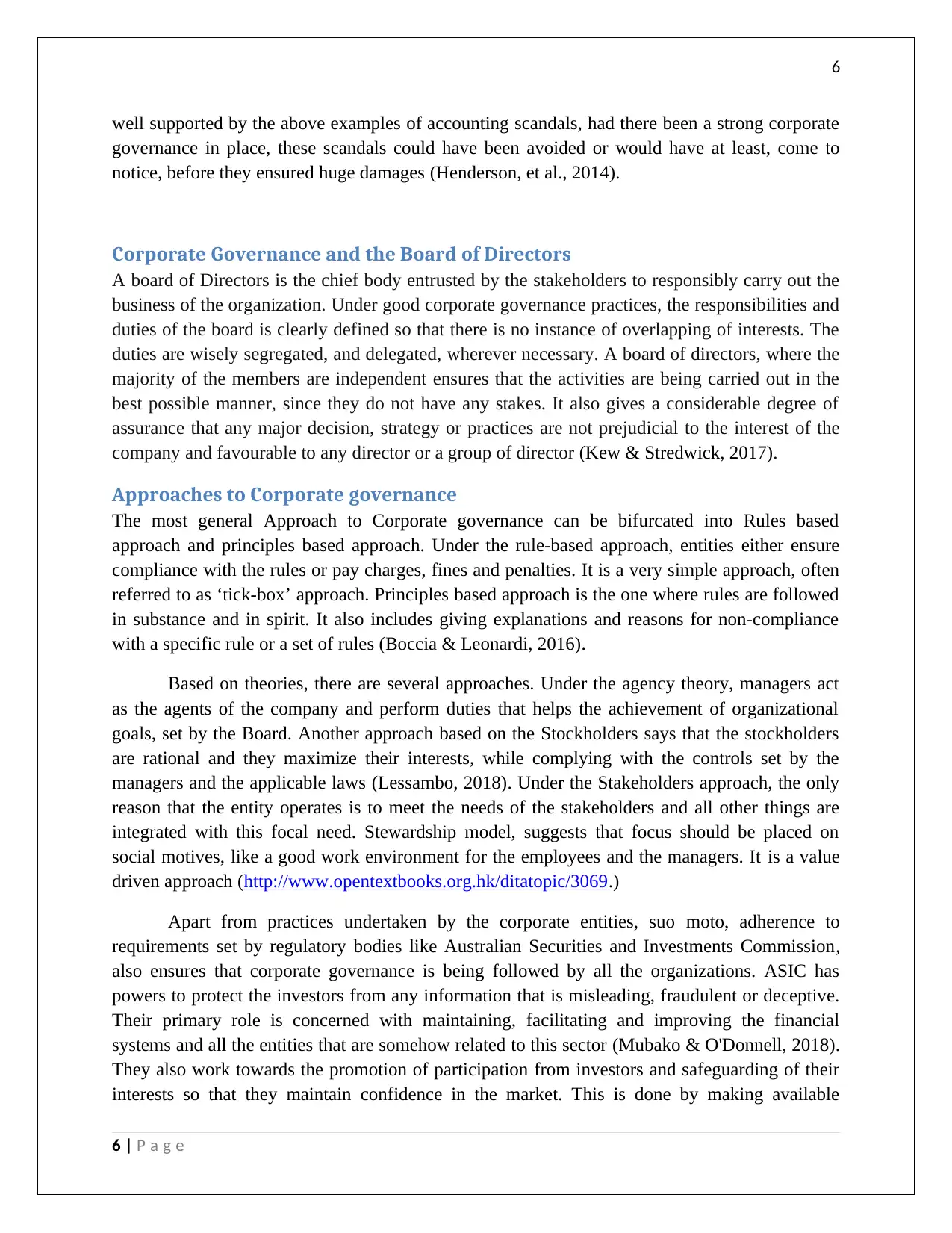
6
well supported by the above examples of accounting scandals, had there been a strong corporate
governance in place, these scandals could have been avoided or would have at least, come to
notice, before they ensured huge damages (Henderson, et al., 2014).
Corporate Governance and the Board of Directors
A board of Directors is the chief body entrusted by the stakeholders to responsibly carry out the
business of the organization. Under good corporate governance practices, the responsibilities and
duties of the board is clearly defined so that there is no instance of overlapping of interests. The
duties are wisely segregated, and delegated, wherever necessary. A board of directors, where the
majority of the members are independent ensures that the activities are being carried out in the
best possible manner, since they do not have any stakes. It also gives a considerable degree of
assurance that any major decision, strategy or practices are not prejudicial to the interest of the
company and favourable to any director or a group of director (Kew & Stredwick, 2017).
Approaches to Corporate governance
The most general Approach to Corporate governance can be bifurcated into Rules based
approach and principles based approach. Under the rule-based approach, entities either ensure
compliance with the rules or pay charges, fines and penalties. It is a very simple approach, often
referred to as ‘tick-box’ approach. Principles based approach is the one where rules are followed
in substance and in spirit. It also includes giving explanations and reasons for non-compliance
with a specific rule or a set of rules (Boccia & Leonardi, 2016).
Based on theories, there are several approaches. Under the agency theory, managers act
as the agents of the company and perform duties that helps the achievement of organizational
goals, set by the Board. Another approach based on the Stockholders says that the stockholders
are rational and they maximize their interests, while complying with the controls set by the
managers and the applicable laws (Lessambo, 2018). Under the Stakeholders approach, the only
reason that the entity operates is to meet the needs of the stakeholders and all other things are
integrated with this focal need. Stewardship model, suggests that focus should be placed on
social motives, like a good work environment for the employees and the managers. It is a value
driven approach (http://www.opentextbooks.org.hk/ditatopic/3069.)
Apart from practices undertaken by the corporate entities, suo moto, adherence to
requirements set by regulatory bodies like Australian Securities and Investments Commission,
also ensures that corporate governance is being followed by all the organizations. ASIC has
powers to protect the investors from any information that is misleading, fraudulent or deceptive.
Their primary role is concerned with maintaining, facilitating and improving the financial
systems and all the entities that are somehow related to this sector (Mubako & O'Donnell, 2018).
They also work towards the promotion of participation from investors and safeguarding of their
interests so that they maintain confidence in the market. This is done by making available
6 | P a g e
well supported by the above examples of accounting scandals, had there been a strong corporate
governance in place, these scandals could have been avoided or would have at least, come to
notice, before they ensured huge damages (Henderson, et al., 2014).
Corporate Governance and the Board of Directors
A board of Directors is the chief body entrusted by the stakeholders to responsibly carry out the
business of the organization. Under good corporate governance practices, the responsibilities and
duties of the board is clearly defined so that there is no instance of overlapping of interests. The
duties are wisely segregated, and delegated, wherever necessary. A board of directors, where the
majority of the members are independent ensures that the activities are being carried out in the
best possible manner, since they do not have any stakes. It also gives a considerable degree of
assurance that any major decision, strategy or practices are not prejudicial to the interest of the
company and favourable to any director or a group of director (Kew & Stredwick, 2017).
Approaches to Corporate governance
The most general Approach to Corporate governance can be bifurcated into Rules based
approach and principles based approach. Under the rule-based approach, entities either ensure
compliance with the rules or pay charges, fines and penalties. It is a very simple approach, often
referred to as ‘tick-box’ approach. Principles based approach is the one where rules are followed
in substance and in spirit. It also includes giving explanations and reasons for non-compliance
with a specific rule or a set of rules (Boccia & Leonardi, 2016).
Based on theories, there are several approaches. Under the agency theory, managers act
as the agents of the company and perform duties that helps the achievement of organizational
goals, set by the Board. Another approach based on the Stockholders says that the stockholders
are rational and they maximize their interests, while complying with the controls set by the
managers and the applicable laws (Lessambo, 2018). Under the Stakeholders approach, the only
reason that the entity operates is to meet the needs of the stakeholders and all other things are
integrated with this focal need. Stewardship model, suggests that focus should be placed on
social motives, like a good work environment for the employees and the managers. It is a value
driven approach (http://www.opentextbooks.org.hk/ditatopic/3069.)
Apart from practices undertaken by the corporate entities, suo moto, adherence to
requirements set by regulatory bodies like Australian Securities and Investments Commission,
also ensures that corporate governance is being followed by all the organizations. ASIC has
powers to protect the investors from any information that is misleading, fraudulent or deceptive.
Their primary role is concerned with maintaining, facilitating and improving the financial
systems and all the entities that are somehow related to this sector (Mubako & O'Donnell, 2018).
They also work towards the promotion of participation from investors and safeguarding of their
interests so that they maintain confidence in the market. This is done by making available
6 | P a g e
Paraphrase This Document
Need a fresh take? Get an instant paraphrase of this document with our AI Paraphraser
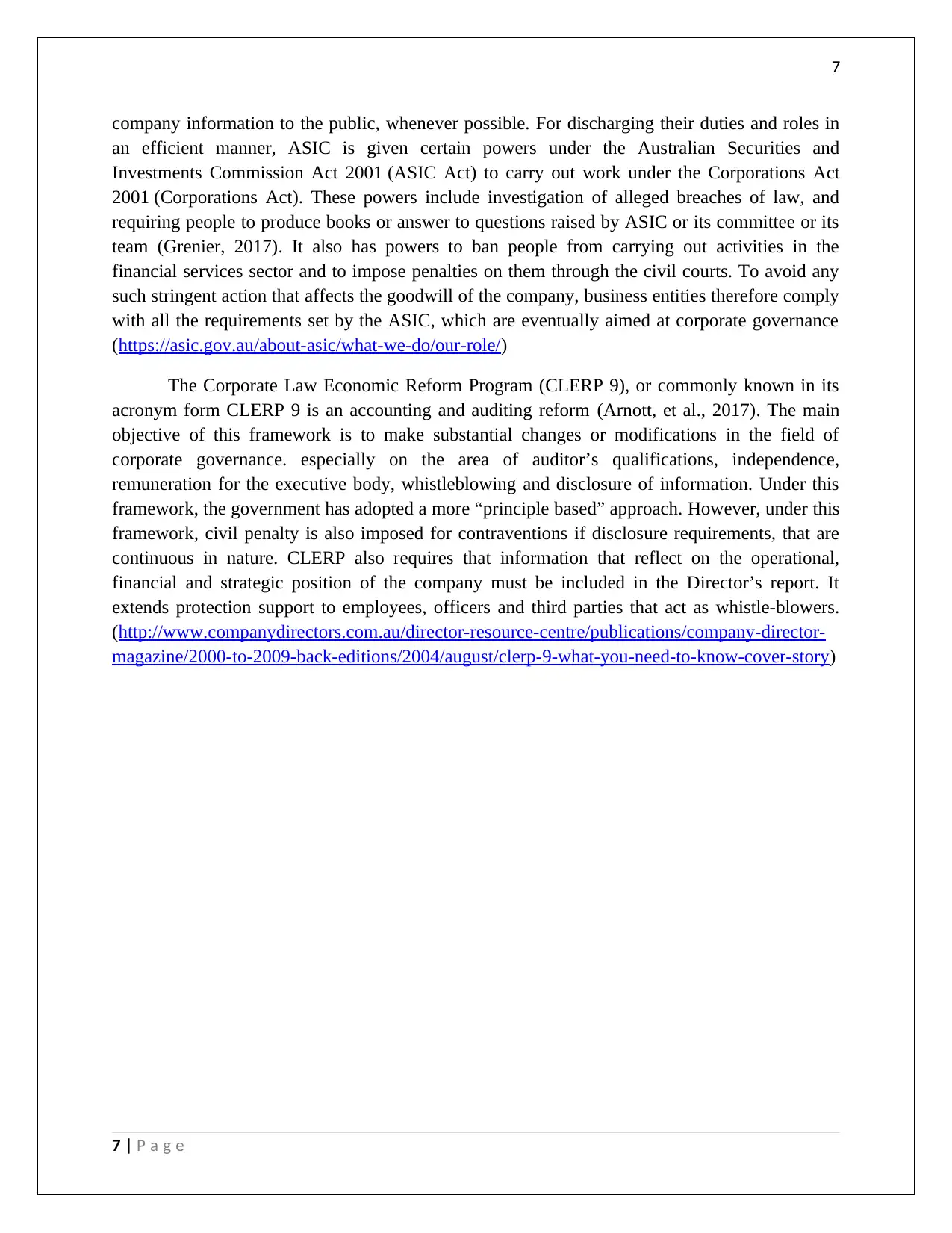
7
company information to the public, whenever possible. For discharging their duties and roles in
an efficient manner, ASIC is given certain powers under the Australian Securities and
Investments Commission Act 2001 (ASIC Act) to carry out work under the Corporations Act
2001 (Corporations Act). These powers include investigation of alleged breaches of law, and
requiring people to produce books or answer to questions raised by ASIC or its committee or its
team (Grenier, 2017). It also has powers to ban people from carrying out activities in the
financial services sector and to impose penalties on them through the civil courts. To avoid any
such stringent action that affects the goodwill of the company, business entities therefore comply
with all the requirements set by the ASIC, which are eventually aimed at corporate governance
(https://asic.gov.au/about-asic/what-we-do/our-role/)
The Corporate Law Economic Reform Program (CLERP 9), or commonly known in its
acronym form CLERP 9 is an accounting and auditing reform (Arnott, et al., 2017). The main
objective of this framework is to make substantial changes or modifications in the field of
corporate governance. especially on the area of auditor’s qualifications, independence,
remuneration for the executive body, whistleblowing and disclosure of information. Under this
framework, the government has adopted a more “principle based” approach. However, under this
framework, civil penalty is also imposed for contraventions if disclosure requirements, that are
continuous in nature. CLERP also requires that information that reflect on the operational,
financial and strategic position of the company must be included in the Director’s report. It
extends protection support to employees, officers and third parties that act as whistle-blowers.
(http://www.companydirectors.com.au/director-resource-centre/publications/company-director-
magazine/2000-to-2009-back-editions/2004/august/clerp-9-what-you-need-to-know-cover-story)
7 | P a g e
company information to the public, whenever possible. For discharging their duties and roles in
an efficient manner, ASIC is given certain powers under the Australian Securities and
Investments Commission Act 2001 (ASIC Act) to carry out work under the Corporations Act
2001 (Corporations Act). These powers include investigation of alleged breaches of law, and
requiring people to produce books or answer to questions raised by ASIC or its committee or its
team (Grenier, 2017). It also has powers to ban people from carrying out activities in the
financial services sector and to impose penalties on them through the civil courts. To avoid any
such stringent action that affects the goodwill of the company, business entities therefore comply
with all the requirements set by the ASIC, which are eventually aimed at corporate governance
(https://asic.gov.au/about-asic/what-we-do/our-role/)
The Corporate Law Economic Reform Program (CLERP 9), or commonly known in its
acronym form CLERP 9 is an accounting and auditing reform (Arnott, et al., 2017). The main
objective of this framework is to make substantial changes or modifications in the field of
corporate governance. especially on the area of auditor’s qualifications, independence,
remuneration for the executive body, whistleblowing and disclosure of information. Under this
framework, the government has adopted a more “principle based” approach. However, under this
framework, civil penalty is also imposed for contraventions if disclosure requirements, that are
continuous in nature. CLERP also requires that information that reflect on the operational,
financial and strategic position of the company must be included in the Director’s report. It
extends protection support to employees, officers and third parties that act as whistle-blowers.
(http://www.companydirectors.com.au/director-resource-centre/publications/company-director-
magazine/2000-to-2009-back-editions/2004/august/clerp-9-what-you-need-to-know-cover-story)
7 | P a g e
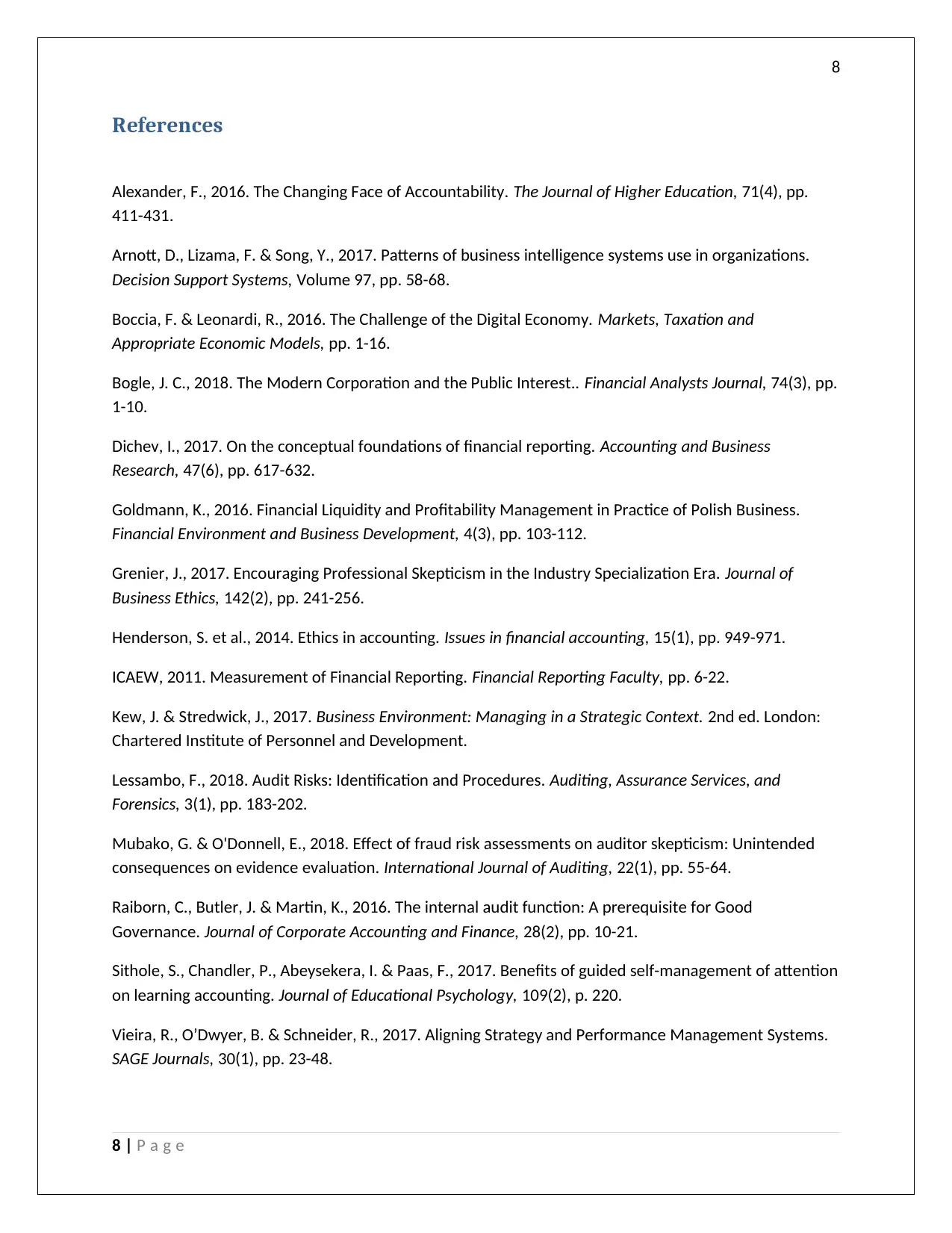
8
References
Alexander, F., 2016. The Changing Face of Accountability. The Journal of Higher Education, 71(4), pp.
411-431.
Arnott, D., Lizama, F. & Song, Y., 2017. Patterns of business intelligence systems use in organizations.
Decision Support Systems, Volume 97, pp. 58-68.
Boccia, F. & Leonardi, R., 2016. The Challenge of the Digital Economy. Markets, Taxation and
Appropriate Economic Models, pp. 1-16.
Bogle, J. C., 2018. The Modern Corporation and the Public Interest.. Financial Analysts Journal, 74(3), pp.
1-10.
Dichev, I., 2017. On the conceptual foundations of financial reporting. Accounting and Business
Research, 47(6), pp. 617-632.
Goldmann, K., 2016. Financial Liquidity and Profitability Management in Practice of Polish Business.
Financial Environment and Business Development, 4(3), pp. 103-112.
Grenier, J., 2017. Encouraging Professional Skepticism in the Industry Specialization Era. Journal of
Business Ethics, 142(2), pp. 241-256.
Henderson, S. et al., 2014. Ethics in accounting. Issues in financial accounting, 15(1), pp. 949-971.
ICAEW, 2011. Measurement of Financial Reporting. Financial Reporting Faculty, pp. 6-22.
Kew, J. & Stredwick, J., 2017. Business Environment: Managing in a Strategic Context. 2nd ed. London:
Chartered Institute of Personnel and Development.
Lessambo, F., 2018. Audit Risks: Identification and Procedures. Auditing, Assurance Services, and
Forensics, 3(1), pp. 183-202.
Mubako, G. & O'Donnell, E., 2018. Effect of fraud risk assessments on auditor skepticism: Unintended
consequences on evidence evaluation. International Journal of Auditing, 22(1), pp. 55-64.
Raiborn, C., Butler, J. & Martin, K., 2016. The internal audit function: A prerequisite for Good
Governance. Journal of Corporate Accounting and Finance, 28(2), pp. 10-21.
Sithole, S., Chandler, P., Abeysekera, I. & Paas, F., 2017. Benefits of guided self-management of attention
on learning accounting. Journal of Educational Psychology, 109(2), p. 220.
Vieira, R., O’Dwyer, B. & Schneider, R., 2017. Aligning Strategy and Performance Management Systems.
SAGE Journals, 30(1), pp. 23-48.
8 | P a g e
References
Alexander, F., 2016. The Changing Face of Accountability. The Journal of Higher Education, 71(4), pp.
411-431.
Arnott, D., Lizama, F. & Song, Y., 2017. Patterns of business intelligence systems use in organizations.
Decision Support Systems, Volume 97, pp. 58-68.
Boccia, F. & Leonardi, R., 2016. The Challenge of the Digital Economy. Markets, Taxation and
Appropriate Economic Models, pp. 1-16.
Bogle, J. C., 2018. The Modern Corporation and the Public Interest.. Financial Analysts Journal, 74(3), pp.
1-10.
Dichev, I., 2017. On the conceptual foundations of financial reporting. Accounting and Business
Research, 47(6), pp. 617-632.
Goldmann, K., 2016. Financial Liquidity and Profitability Management in Practice of Polish Business.
Financial Environment and Business Development, 4(3), pp. 103-112.
Grenier, J., 2017. Encouraging Professional Skepticism in the Industry Specialization Era. Journal of
Business Ethics, 142(2), pp. 241-256.
Henderson, S. et al., 2014. Ethics in accounting. Issues in financial accounting, 15(1), pp. 949-971.
ICAEW, 2011. Measurement of Financial Reporting. Financial Reporting Faculty, pp. 6-22.
Kew, J. & Stredwick, J., 2017. Business Environment: Managing in a Strategic Context. 2nd ed. London:
Chartered Institute of Personnel and Development.
Lessambo, F., 2018. Audit Risks: Identification and Procedures. Auditing, Assurance Services, and
Forensics, 3(1), pp. 183-202.
Mubako, G. & O'Donnell, E., 2018. Effect of fraud risk assessments on auditor skepticism: Unintended
consequences on evidence evaluation. International Journal of Auditing, 22(1), pp. 55-64.
Raiborn, C., Butler, J. & Martin, K., 2016. The internal audit function: A prerequisite for Good
Governance. Journal of Corporate Accounting and Finance, 28(2), pp. 10-21.
Sithole, S., Chandler, P., Abeysekera, I. & Paas, F., 2017. Benefits of guided self-management of attention
on learning accounting. Journal of Educational Psychology, 109(2), p. 220.
Vieira, R., O’Dwyer, B. & Schneider, R., 2017. Aligning Strategy and Performance Management Systems.
SAGE Journals, 30(1), pp. 23-48.
8 | P a g e
⊘ This is a preview!⊘
Do you want full access?
Subscribe today to unlock all pages.

Trusted by 1+ million students worldwide
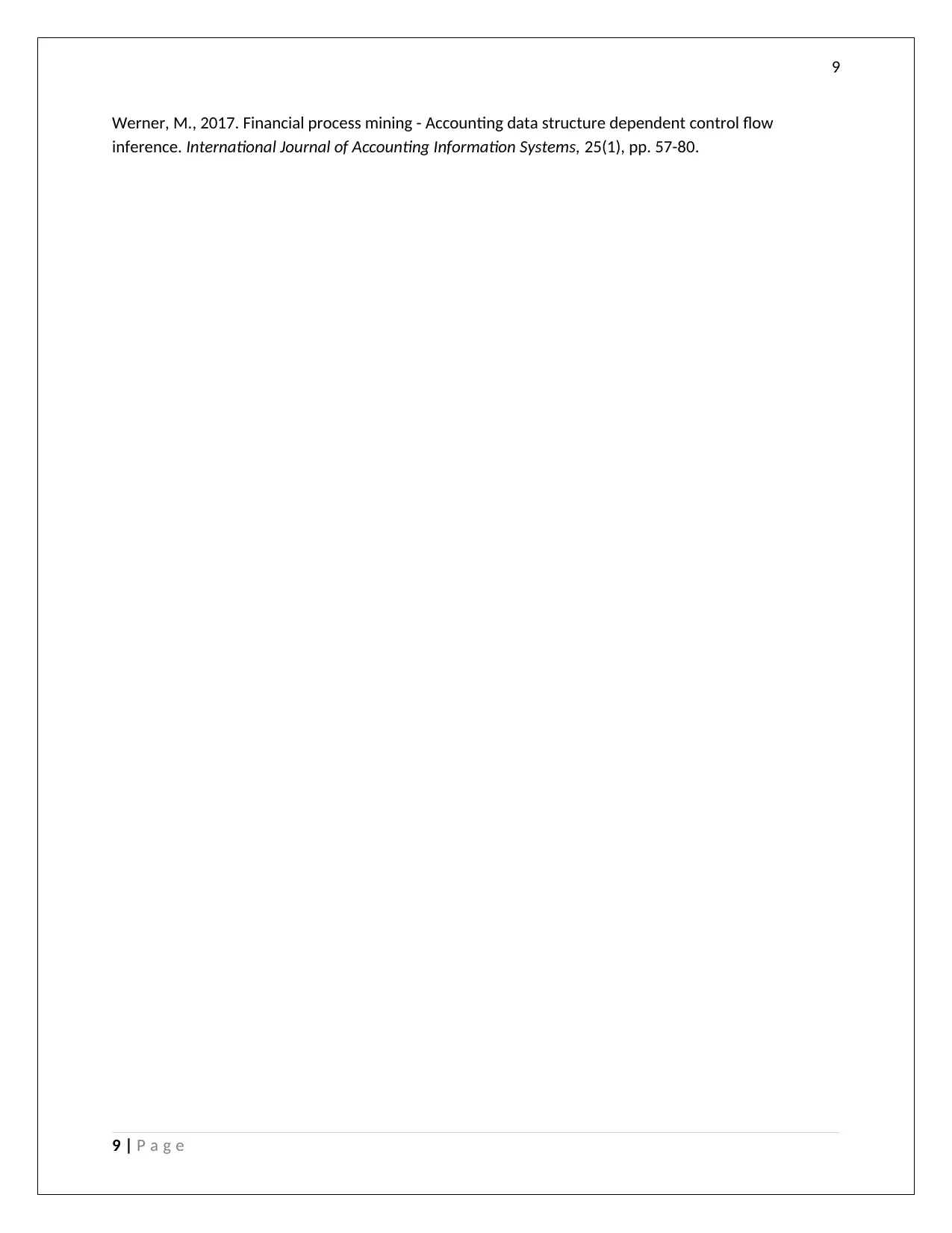
9
Werner, M., 2017. Financial process mining - Accounting data structure dependent control flow
inference. International Journal of Accounting Information Systems, 25(1), pp. 57-80.
9 | P a g e
Werner, M., 2017. Financial process mining - Accounting data structure dependent control flow
inference. International Journal of Accounting Information Systems, 25(1), pp. 57-80.
9 | P a g e
1 out of 10
Related Documents
Your All-in-One AI-Powered Toolkit for Academic Success.
+13062052269
info@desklib.com
Available 24*7 on WhatsApp / Email
![[object Object]](/_next/static/media/star-bottom.7253800d.svg)
Unlock your academic potential
Copyright © 2020–2025 A2Z Services. All Rights Reserved. Developed and managed by ZUCOL.





